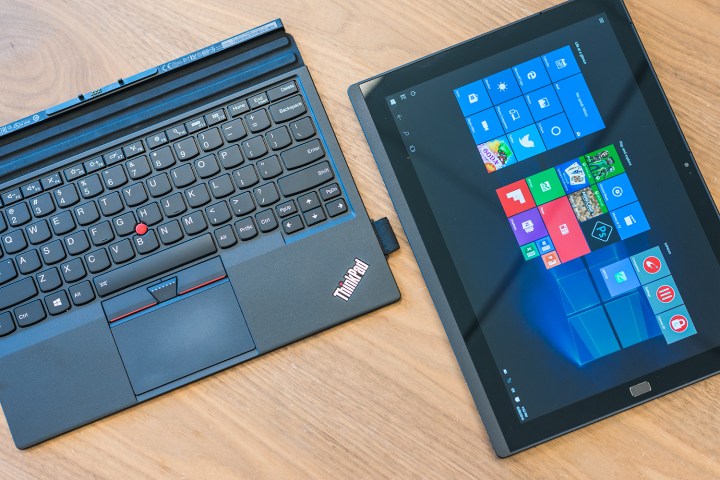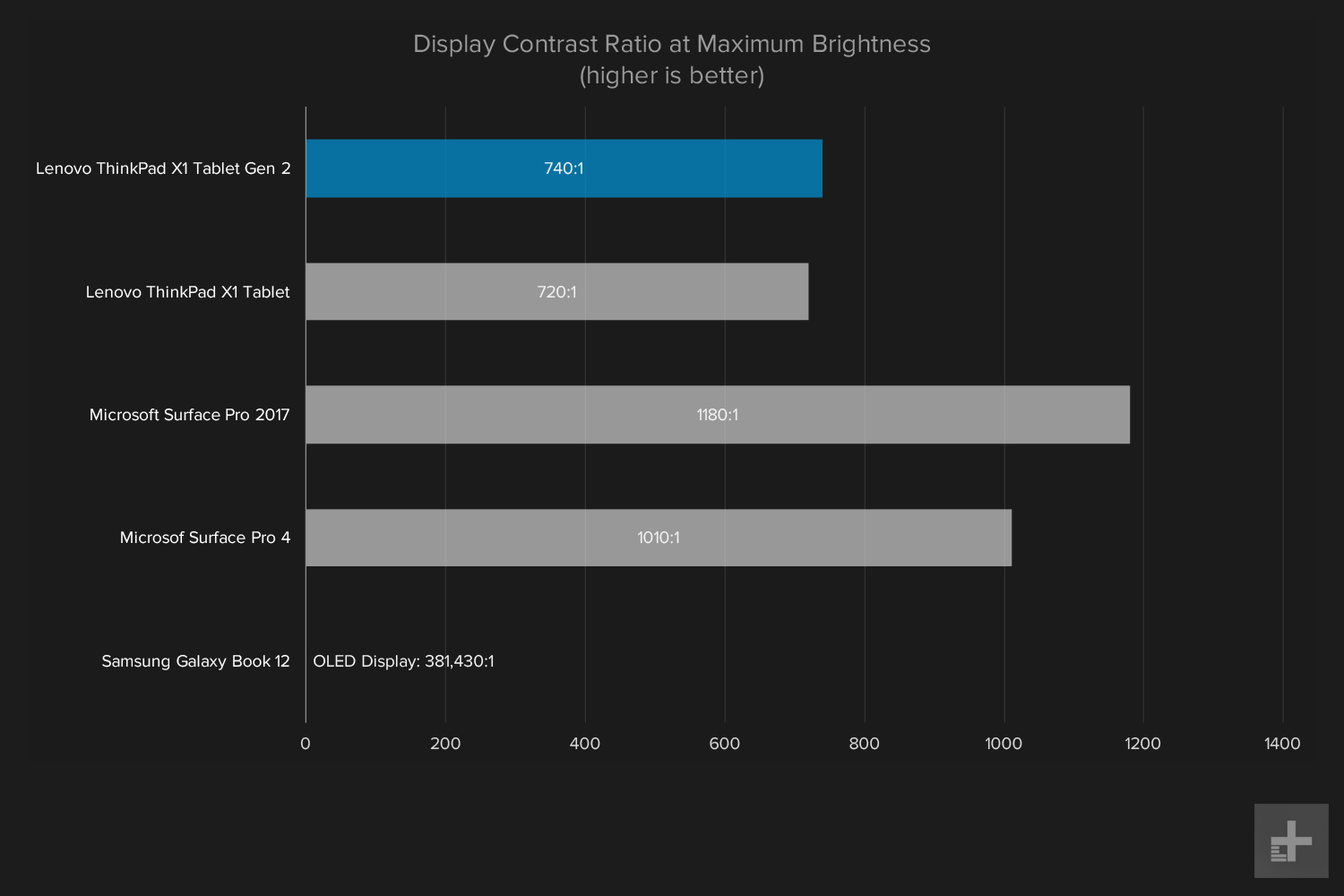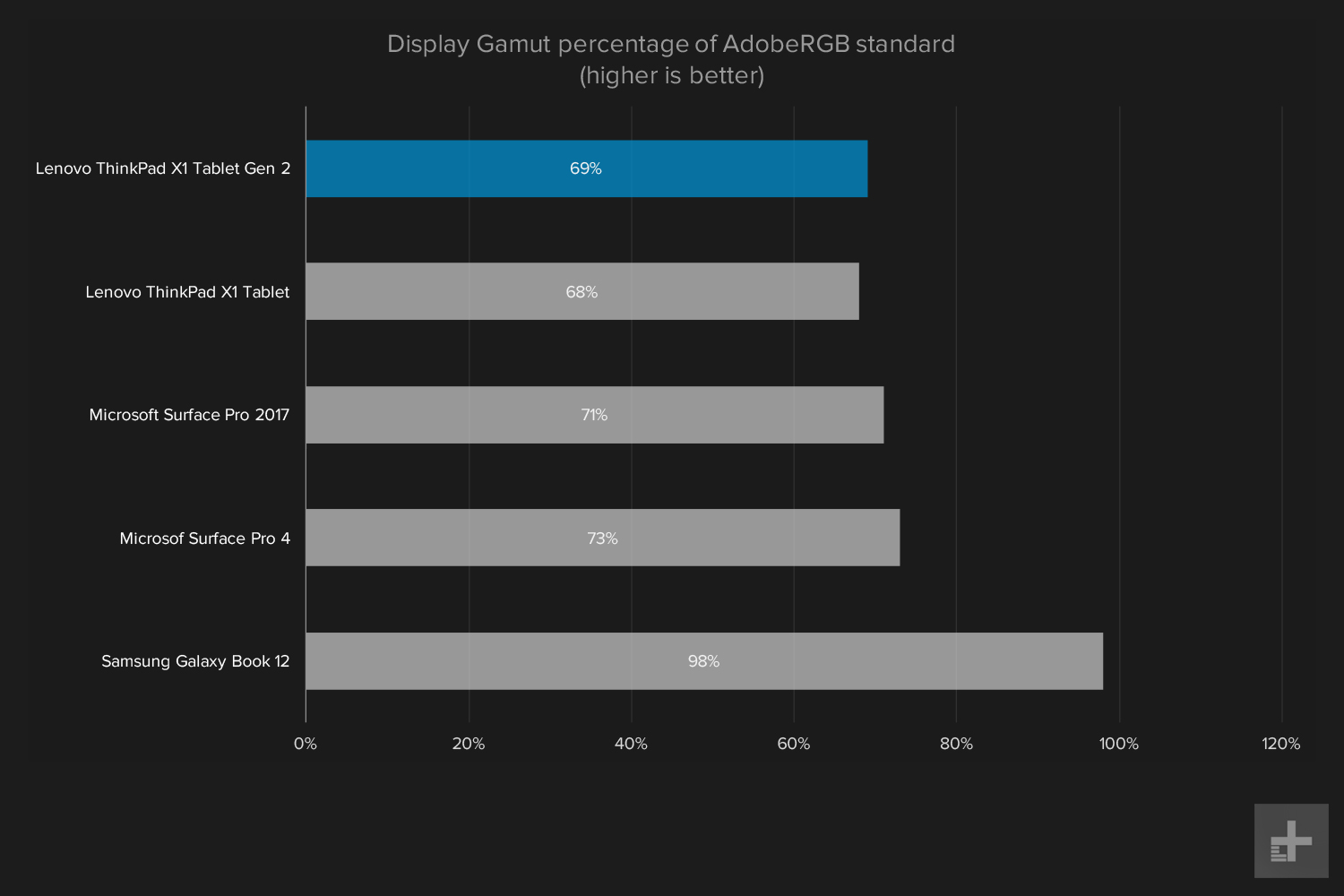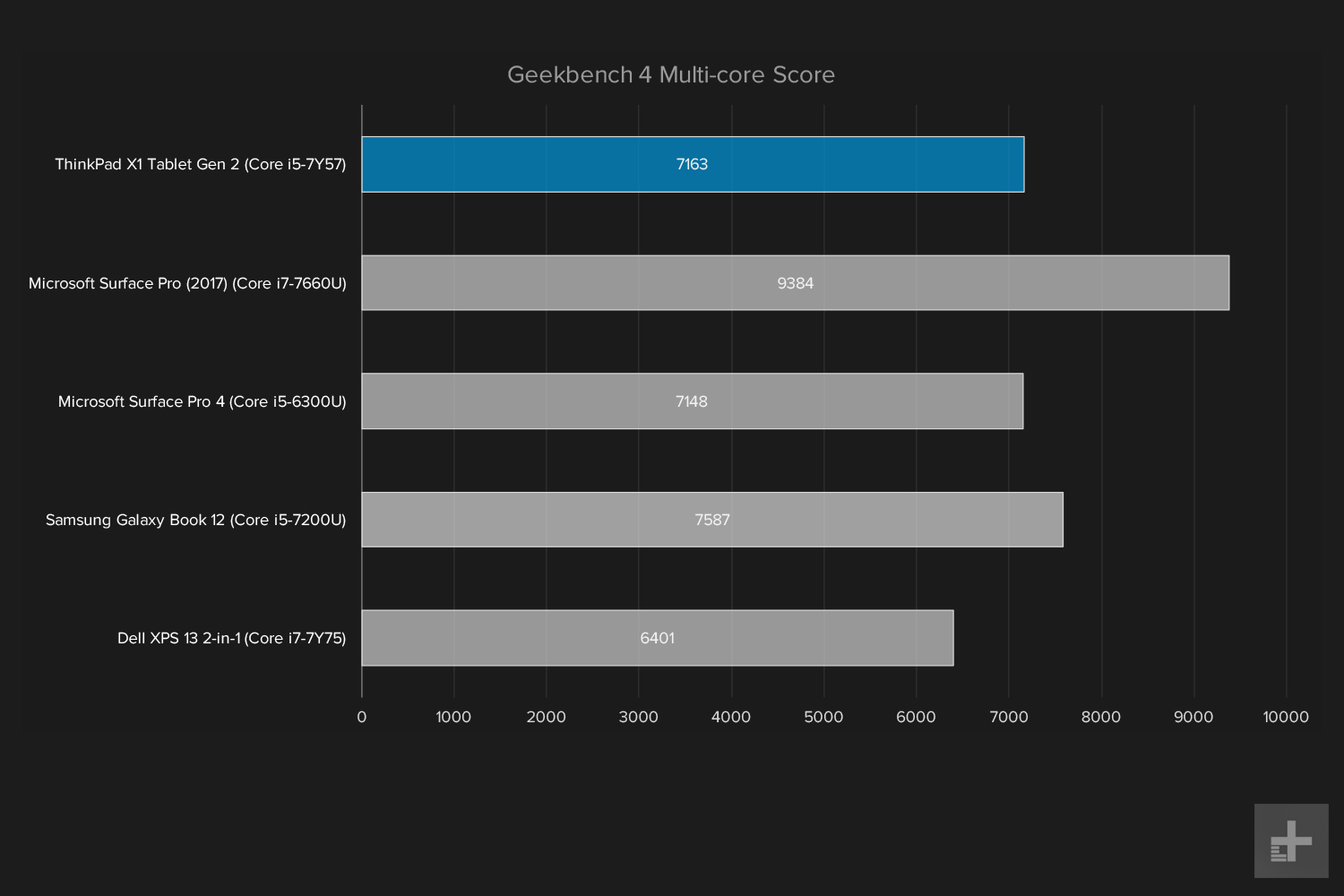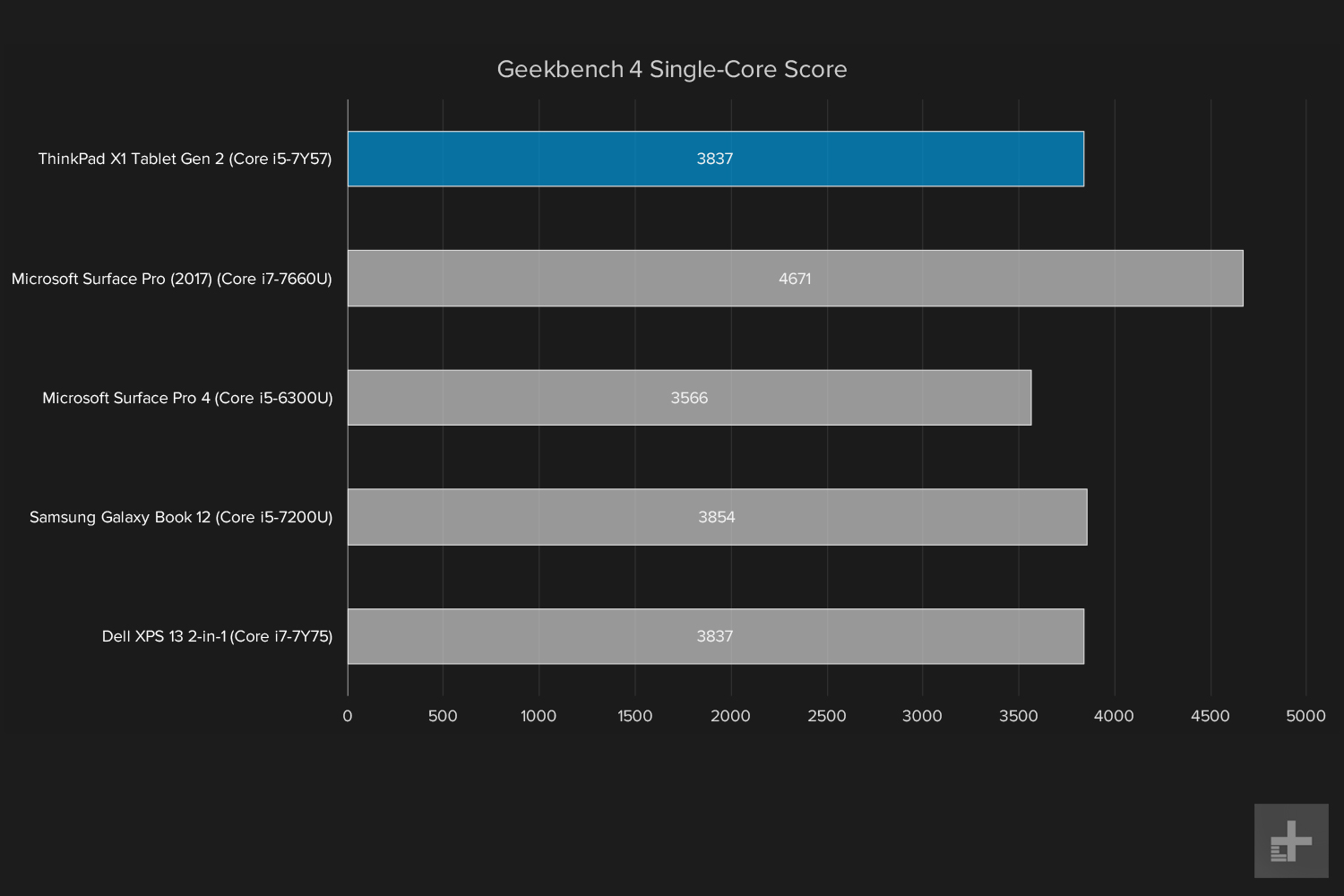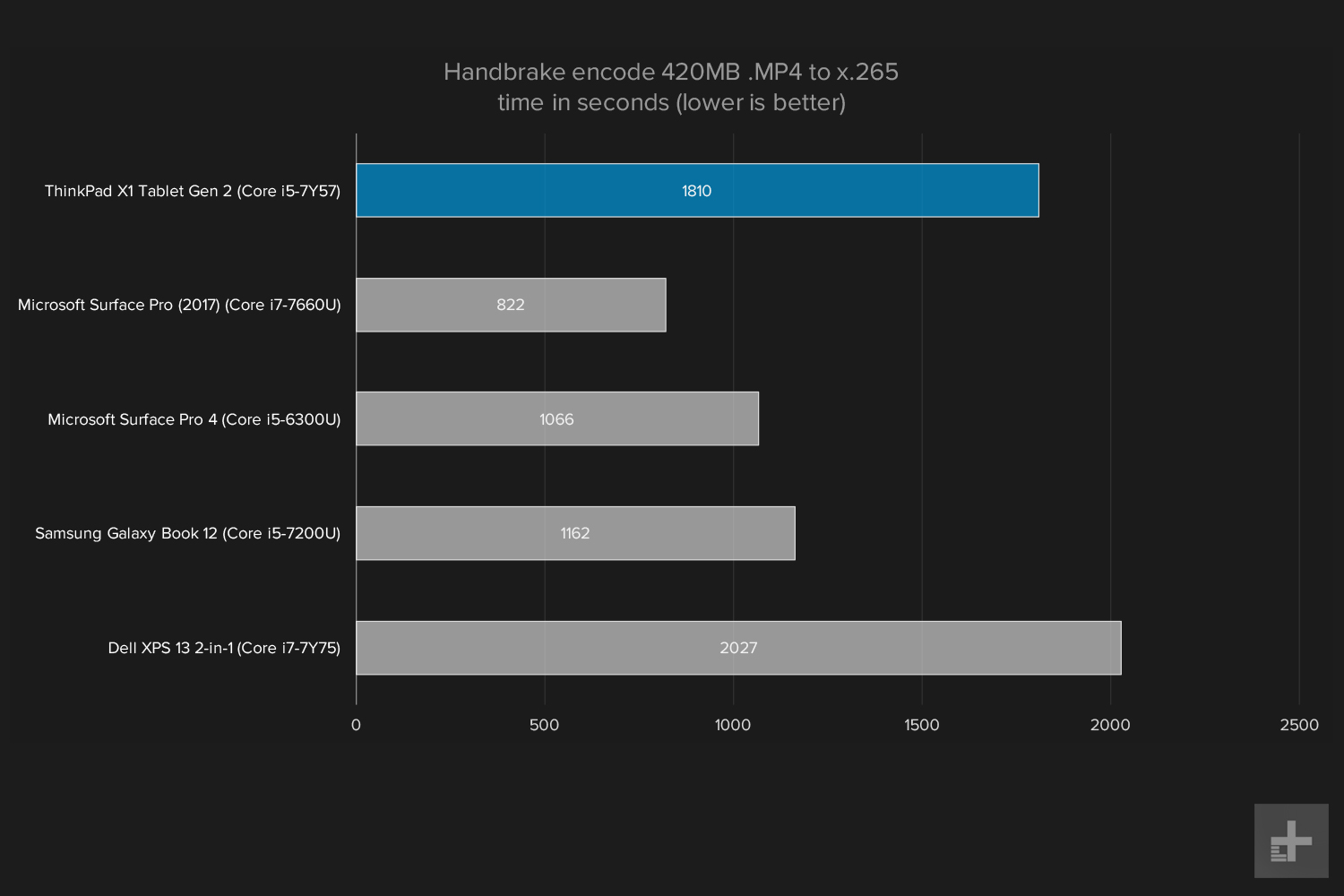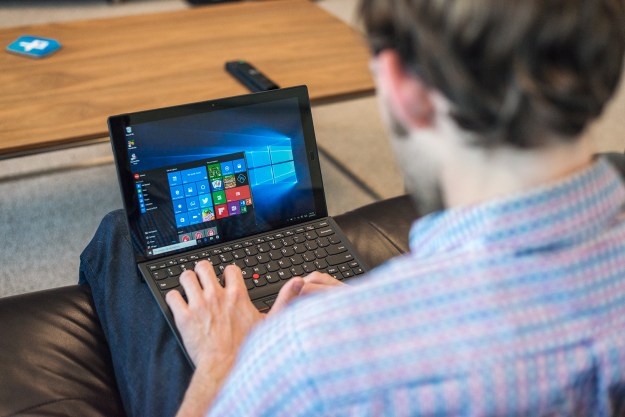
“Lenovo’s ThinkPad X1 Tablet is a workhorse 2-in-1, but it’s too expensive.”
- Solid productivity performance
- Excellent detachable keyboard
- Unique expansion options
- Fanless design
- Strong build quality test for MIL-SPEC 810G
- Not as sleek as Surface Pro
- Can get hot when working hard
- Display doesn’t measure up for the price
- Battery life is just ok
Microsoft wanted Windows 2-in-1s to happen so badly that it stopped waiting for the OEMs and built its own. After years of mixed results, devices like the Surface Pro and the Surface Book are widely regarded today, showing the world just how useful a Windows tablet can be. That has left computer manufacturers in the odd position of trying to catch up with Microsoft, their longtime partner – and increasingly, they’re succeeding.
Lenovo’s latest Surface competitor, the ThinkPad X1 Tablet, is currently in its second generation, and could be one of the recent success stories. The device, which comes complete with a ThinkPad keyboard and ThinkPad Pen Pro, starts at $1,449 with a seventh-generation Intel Core i5-7Y54 processor, 8GB of RAM, and 128G SSD. The Lenovo ThinkPad X1 Tablet review unit we received, priced at $1,689, was upgraded to Intel’s Core i5-7Y57, 8GB of
Can the Lenovo ThinkPad X1 Tablet Gen 2 manage to be a tablet and a ThinkPad, all at once? And is there any reason to get this over a Surface Pro?
Effective, though confusing at first
The ThinkPad brand has had a particular look since the 90s, and Lenovo has always been careful to respect that aesthetic. The ThinkPad X1 Tablet Gen 2 brings that look to the tablet market, with some obvious influence from the Surface Pro line thrown in. The result is exactly what you’d expect when you hear the words “ThinkPad tablet,” right down to the defined corners and the iconic face of the keyboard, complete with the obligatory red dot.
When we first picked up the ThinkPad X1 Tablet, we were slightly puzzled. The keyboard attachment and the tablet were easy to identify, and putting them together isn’t rocket science by any means. A secure magnetic latch snaps into place and holds firm. But to sit everything on a desk or table, the user needs to unlock the metal kickstand on the back of the tablet that serves as a sturdy counterweight. The mechanism’s workings aren’t obvious at a glance.
Once you work this out, using the ThinkPad X1 Tablet Gen 2 is easy. To adjust the angle of the screen, users must avoid the urge to tilt the screen itself and instead adjust the kickstand. The hinge is solid, and its presence means the keyboard doesn’t have to serve as counterweight to the tablet, which saves both space and weight. Overall, the design is just as solid as typical for the ThinkPad line, with the machine tested to meet MIL-SPEC 810G requirements for durability.
This otherwise top-heavy tablet works comfortably docked on a desk, or even your lap. The Lenovo also differs from the Surface Pro and similar machines in that the kickstand hinge is at the bottom rather than the middle of the chassis. The kickstand therefore levers downward to lay flat on a surface — which does tend to make it a more comfortable laptop experience than Microsoft’s design.
The tablet is 11.45 by 8.24 inches, and weighs 2.4 pounds with the keyboard attached, dimensions that are the same as the original model. The tablet itself is .33 inches thick, which is the same as the Surface Pro and slightly thicker than the iPad Pro’s .27 inches. The ThinkPad X1’s keyboard attachment is .20 inches thick, so everything is just over a half inch thick when docked and closed.
These dimensions make the ThinkPad X1 Tablet relatively large and heavy for a 2-in-1. However, a total thickness of a half-inch with keyboard isn’t massive, and the size never annoyed us. Overall, the ThinkPad X1 manages to be like a tablet and a ThinkPad all at once, which isn’t easy to pull off.
All the input devices, please
Our ThinkPad X1 Tablet came with five distinct input devices. There’s the touchscreen, the optional ThinkPad Pen Pro, and the keyboard attachment, which in addition to its keys offers a touchpad and a trackpointer.
The touchscreen felt great in our tests. The surface was smooth and consistent, as you’d expect, and gestures were all correctly identified. And if you want more precision than your greasy fingers can offer, the ThinkPad Pen Pro delivers. It makes stylus input quite natural, and works well with the Windows 10 desktop thanks to its built-in buttons for right and left clicking. Hover a bit above the screen and you’ll see a pointer, which makes it easy to avoid accidentally tapping a button or icon. Naturally, the Pen Pro supports all of the usual Windows 10 Ink functionality.
The design is just as solid as usual for the ThinkPad line, highlighted by MIL-SPEC 810G durability testing.
While the ThinkPad X1 Tablet keyboard doesn’t quite measure up to the keyboard on a ThinkPad laptop, it comes close. The keys are what you’d expect from a ThinkPad. They’re well-spaced, and give enough feedback for touch typists to develop a flow. Of course, certain compromises had to be made to fit a keyboard into a small cover, so don’t expect the full ThinkPad keyboard experience. The depth of each keystroke is noticeably shorter, which dampens the tactile experience. Having said that, this is the closest thing to a ThinkPad keyboard available for any tablet, and is among the nicest tablet keyboards we’ve used.
The keyboard is backlit with two brightness levels and an ambient light sensor for automatic brightness, though backlighting is disabled by default. To enable it, you’ll need to hold “Fn” and hit “Space,” which are easy enough keys to find in the dark. Speaking of the keys, some were in odd places, such as the left Fn and Ctrl keys that are reversed and take some real getting used to.
Some magnets placed in the keyboard cover snap onto the bezel, giving you a pleasant angle for typing. Typing is easier at an angle, but this arrangement does create some keyboard flexing that makes typing a bit louder. That could be a problem if you’re using the tablet beside a sensitive neighbor.
The touchpad is quite small, two by three and a half inches. Input was accurate, and the texture is pleasant. As with most ThinkPad touchpads, it’s smaller than it could be because of the need to offer buttons to trackpointer users. Speaking of, there’s the trackpoint, the longtime staple of the ThinkPad line. It honestly seems like an anachronism on a tablet, but we’re sure longtime ThinkPad fans will enjoy its inclusion. It works well, as usual, with smooth tracking that offers another efficient control option.
Users hoping to login to their tablet without a touchpad will enjoy the Windows Hello compatible fingerprint reader. It’s located next to the display on the right-hand side, so it’s readily accessible no matter how you’re using the 2-in-1 device.
Not many ports, but you can buy attachments for more
The ThinkPad X1 Tablet offers one USB 3.0 port on the side of the tablet itself, alongside a USB type-C port for connecting the tablet to a power supply. A mini-DisplayPort makes it possible to connect external displays, and a headphone jack works with external speakers. There’s also a microSD port.
Battery life was improved over the previous model but could certainly be better.
There are no ports whatsoever on the keyboard, but Lenovo has left room for more with a unique module system. You can snap attachments between the keyboard and the tablet, giving you extra features. A $150 productivity module gives you an HDMI port, a Onelink+ Port for docking, another USB 3.0 port, and a two-cell battery rated for five additional hours of usage. Another attachment offers a built-in projector. We weren’t able to try any of these attachments out, but they’re interesting in concept.
Wireless capabilities are handled by the Intel 8265AC+BT card, which provides 2×2 802.11ac and Bluetooth 4.1 connectivity. There’s also a NanoSIM port for adding in cellular connectivity.
The display gets the job done
The 12-inch display offered by the ThinkPad X1 Tablet offers a resolution of 2,160 by 1,440, which is generous. The display is unchanged on the updated version. Despite being relatively small, there always seems to be room to work.
At full brightness, the ThinkPad X1 puts out 389 nits, which is exceptional. Using this device outside shouldn’t be a problem. The contrast was 740:1 at max brightness, which is fairly average today and nowhere close to the absurd 381,430:1 rating of the Samsung Galaxy Book 12 (which has an OLED display), and also considerably behind others like Microsoft’s Surface Pro at 1180:1.
Color is more of an issue. Our results showed the Tablet X1 Gen 2 hitting just 69 percent of the AdobeRGB standard, which isn’t terrible, but is one of the lower results we’ve seen among high-end devices lately. The sRGB scale rating was 93 percent, which is also below average for the class. Microsoft’s Surface Pro hit 71 percent and 96 percent, and Samsung’s Galaxy Book 12 hit 98 and 100 percent, respectively. Color accuracy wasn’t bad, however, at 1.99, although scores less than 1.0 are considered excellent in this test.
Numbers are one thing. Experience is another. While the X1 doesn’t quite measure up on paper, it’s still good enough to deliver an enjoyable experience, and it’s certainly a great productivity experience with its sharpness and solid — albeit slightly muted — colors.
Moving on to live action, we watched the trailer for Star Trek Beyond. It was easy to make out every detail of the unnecessary chaos and carnage, even in darker scenes with a lot of shadow. The spirit of exploration and hopefulness that once defined this franchise could not be detected, but that is no fault of the display.
If anything, the ThinkPad X1’s lackluster showing is evidence of how far mobile PC displays have come. You might think it’s fine if it’s all you ever saw. When placed next to a Surface Pro or Samsung Galaxy Book, though, its flaws are easy to notice.
Grab your headphones. Seriously.
Audio is a different matter. Everything is clear and easy to make out, but bass and midrange tones are muddled. You can’t really rock out to these speakers, but you’ll be able to make out music or podcasts from across the room. External speakers or headphones are highly recommended.
Of course, many small PCs suffer speaker woes. Yet we’ve noticed some improvement in this area. The Samsung Galaxy Book was very strong, and Huawei’s super-thin Matebook X laptop delivers incredible volume for its size.
A powerful mobile processor
The ThinkPad X1 Tablet Gen 2 is now powered by a seventh-generation Intel Core i5-7Y57 processor. The Core Y-Series (which used to be labeled with the M designation) isn’t as powerful as the better-known Core i5 and i7, as it seeks to balance performance with better battery life.
In Geekbench 4, the ThinkPad’s single core rating was 3,837 and the multi-core score was 7,163, which are both competitive with the comparison group, excluding the excellent score posted by the new Surface Pro and it’s full-speed Core i7. The ThinkPad X1 can keep up with most Windows 10 tablets on the market right now, at least in this benchmark.
Performance was good enough that we forgot this entire machine was crammed into a tablet form factor.
Our more demanding Handbrake test, however, which encodes a 420MB video file to H.265 format, tells a different story. In this test, The ThinkPad X1 Tablet Gen 2 took 1,810 seconds to complete the run, which is second only to the Dell XPS 13 2-in-1 that, surprisingly, uses the somewhat faster Core i7-7Y75. Other Intel Core-based systems posted much stronger scores, demonstrating that there’s a reason why the Core Y-Series is reserved to thin systems.
In day-to-day usage, however, performance was good enough that we forgot this entire machine was crammed into a tablet form factor. Browsing the web and writing were no problem, and neither were more demanding productivity tasks. We just wouldn’t suggest you consider the machine if you need to perform more processor-intensive tasks such as video encoding. For that kind of work, the Surface Pro is a much better tablet choice.
Another important note is that this version of the ThinkPad X1 Tablet is fanless, just like the previous version. That means it stays completely silent no matter the workload. The back of the machine does become hot, however. That’s not as much of a concern with this class of machine when it’s upright on your lap, but it can get uncomfortable when you’re holding it in your hands.
Very solid state performance
The ThinkPad X1 Tablet Gen 2 stepped up to the excellent Samsung PM961 solid-state disk (SSD), which is an improvement over the previous model’s Samsung M.2 2280 SSD. Our review unit was equipped with the 256GB version of this drive, which is important, because the 128GB model uses the much slower SATA connection.
How fast is the drive? Simply put, it’s a significant improvement over the previous model. Our CrystalDiskMark benchmark showed a read speed of 1,478 megabytes per second, which is a very good score, although a little low for this SSD. Write speed came in at 1,237 MB/s, which is simply an excellent score. That places the ThinkPad X1 Tablet Gen 2 on solid footing compared to its competition.
In practice, the machine was just as fast as expected. It boots quickly, and opening and saving files was quick and efficient. You won’t find storage speed to be an issue with this detachable tablet.
Not much for gaming
There’s not a lot of room for dedicated graphics cards inside tablets, so they’re powered by on-board graphics. The ThinkPad X1 Tablet Gen 2 uses Intel HD graphics 615, which isn’t a powerhouse.

Not surprisingly, the Lenovo met our very low expectations. Its Fire Strike score of 688 is about what you’d expect, and slightly below the typical tablet. The Surface Pro’s Intel Iris Plus graphics were far more powerful in this test, as was the discrete Nvidia GeForce 940MX GPU in the much larger HP Spectre x360 15 2-in-1.
To see how this 2-in-1 handles real-world gaming, we fired up Civilization VI. We started at Full HD (1,920 x 1,080) resolution and Medium graphics options and not resolution, and proceeded to watch what was essentially a slide show. The ThinkPad X1 Tablet Gen 2 could only manage 7.7 frames per second (FPS) on these settings, which dropped to a little more than half when we ran the benchmark on Ultra graphics settings.
Obviously, detachable tablets aren’t meant for running modern games, and Lenovo’s latest version is no different. You can play some casual games and older titles if you like, but certainly don’t grab a tablet if hardcore gaming is anywhere on your horizon.
Light on its feet
This tablet weighs 2.4 pounds when docked with the keyboard, and is just over a half-inch thick total. It can easily fit in your bag, and is light enough that you’ll wonder multiple times during a long trip whether you’ve forgotten it somewhere. The ThinkPad X1 Tablet Gen 2 retains the 37 watt-hour battery of the previous model, which was a bit underwhelming in terms of longevity.
Lenovo’s upgrade to Intel’s more efficient seventh-generation CPU did improve battery life. On our Peacekeeper battery benchmark, which runs several browser-based tasks on a loop until the battery ultimately dies, gave us five hours and two minutes, a stronger score than the last version’s three hours and four minutes of battery life. That puts the machine in a much more competitive position.
The new model fell off a bit in our web browsing loop, during which a number of popular websites are loaded automatically until the battery dies. It lasted only five hours and 20 minutes, compared to the previous model’s five hours and 46 minutes. The Gen 2 model battery redeemed itself a bit while looping a movie trailer, lasting eight hours and 16 minutes compared to the first generation’s seven hours and 40 minutes.
The improvements put the ThinkPad X1 Tablet Gen 2 in somewhat better standing against its competition. The Surface Pro, for example, ran for five hours and 21 minutes in our Peacekeeper test, just 19 minutes longer than the Lenovo, with an almost identical difference in our web browsing test. And the ThinkPad X1 Tablet surpassed the Samsung Galaxy Book 12 on both tests.
The Lenovo did fall short in our video looping test, however. Both the Surface Pro and the Samsung Galaxy Book 12 exceeded 10 hours, while the ThinkPad X1 Tablet barely broke the eight-hour mark. That’s not a terrible score but it does fall short of its main competition.
Overall, battery life was improved over the previous model, but could certainly be better, which is probably why Lenovo is selling an attachment with an extra battery.
Software
Lenovo didn’t overburden the ThinkPad X1 Tablet Gen 2, a Microsoft Signature Edition unit, with much extraneous software. In addition, to the usual Microsoft first-party Windows 10 apps and handful of games, there are a couple of useful Lenovo utilities. The Lenovo Settings app, in particular, is handy for getting at specialized settings like the Intelligent Cooling function that can keep things from getting too hot and the microphone settings to suppress keyboard noise while recording and optimize for voice communications.
Warranty
Lenovo offers a one-year warranty for the Lenovo ThinkPad X1 Tablet Gen 2, which is standard for
Our Take
The ThinkPad X1 Tablet is not a perfect 2-in-1, but it is a good one. It offers a robust build that’s more resistant to dings and dents than most tablets, and its detachable keyboard is superior to most. It’s held back, however, by a mediocre display and so-so battery life, two traits important to every tablet.
Is there a better alternative?
The most obvious competitor to the Lenovo ThinkPad X1 Tablet Gen 2 is Microsoft’s new Surface Pro. They’re both priced similarly, for example. Our X1 review unit with an Intel Core i5-7Y57 CPU, 8GB of
The Surface Pro wins out in terms of performance and battery life, however. It’s significantly faster, particularly in more processor-intensive tasks, even though it uses a full-power processor, it also lasts longer on a charge thanks to its larger battery. And, its display is significantly better than the one used on the ThinkPad X1 Tablet — really, it’s not even close. Unless you need the ThinkPad’s more robust design, then it’s hard to recommend over Microsoft’s offering.
A 360-degree 2-in-1 is also a viable alternative to a detachable tablet today, and they tend to be a little more reasonably priced. The HP Spectre x360 13, for example, is one our favorites, and it runs a more compelling $1,090 with the same components and a
How long will it last?
The Lenovo ThinkPad X1 Tablet Gen 2 benefits from its USB Type-C port, generous connectivity add-ons, and durability. Its performance and battery life are enough to keep you going for years, at least in today’s and tomorrow’s productivity tasks. All in all, the machine is a solid long-term investment.
Should you buy it?
Only if you need a MIL-SPEC tested tablet with numerous connectivity options. The Lenovo ThinkPad X1 Tablet Gen 2 is durable, and has many useful add-ons that most competitors don’t even try to offer. However, the X1 falls behind the Surface Pro in key areas, and it’s incredibly expensive.

